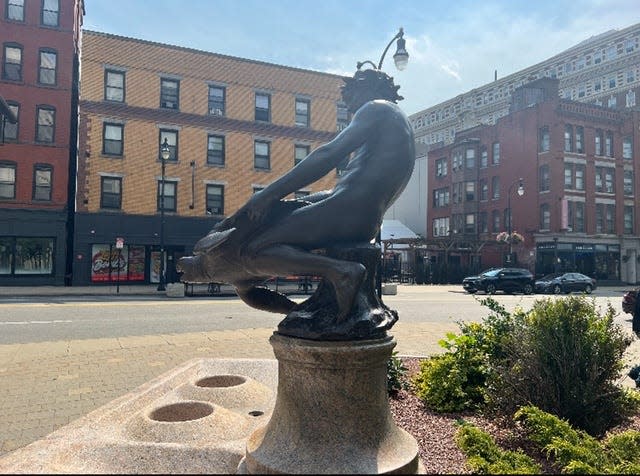What’s the story behind the 'Turtle Boy' statue in Worcester?

It has graced the front of postcards, stickers and T-shirts.
It has inspired an outspoken blog, offbeat songs, even a children’s book.
It has been vandalized, mysteriously vanished and reappeared without warning.
Despite being mocked, criticized and laughed at, locals love taking selfies with it.
While its proper name is the Burnside Fountain, most people know it as Turtle Boy or the Turtle Boy statue.
What is the Turtle Boy statue?
The half-ton bronze sculpture, depicting a boy holding a hawksbill sea turtle just below his knees.
Where is Turtle Boy located?
Originally placed in Central Square, it was moved to Worcester Common facing Salem Square in 1969. It was stolen in May 1970, returned later that year, placed back on its pedestal in 1972, toppled over in 2004 and placed back on its pedestal later that year.
Who is responsible for the Turtle Boy statue?
New York-based artist Charles Y. Harvey.
Whatever happened to Harvey?
On the morning of Jan. 28, 1912, in Bronx Park in New York, students found the body of a man lying face up in the grass. It was Harvey. His throat was cut. On the ground nearby lay two razors.
“Harvey was bitterly despondent about his work and so sensitive to the slightest criticism that any expression of adverse opinion caused him genuine suffering,” the artist's obituary in the Jan. 29, 1912, edition of The New York Times read. “His friends and fellow craftsmen, however, were most favorably impressed with the unfinished work that stands in his studio. It is the life-size figure of a crouching boy, holding a tortoise.”
The obituary continued: “But the work of his hands dissatisfied him and, as he tried to make headway, he was haunted by the voices of unseen persona, who bade him take his life. The command was explicit. The voices, from which he could not escape, directed relentlessly that he lay aside his tools and kill himself.”
How old was Harvey when he died?
Harvey was 43.
What happened to the Turtle Boy statue after Harvey’s death?
Sculptor Sherry Edmundson Fry finished the statue.
How did Turtle Boy make its way to Worcester?
In 1905, Harriet P.F. Burnside had bequeathed the city $5,000 to create a fountain to provide fresh water for people, horses and dogs. The donation was in memory of her father, Samuel M. Burnside, a prominent Worcester lawyer. The Burnside Memorial has been a part of the Worcester scene since October 1912. There were no special ceremonies in connection with its unveiling.
How has Turtle Boy changed his look over the years?
Over the years, Turtle Boy has been dressed with objects, including Mardi Gras beads, a knitted hat and scarf, and, during the pandemic, a face mask.
What was the true intention of the artist behind Turtle Boy?
In a Feb. 27, 2011, story in the Telegram & Gazette, Kristina Wilson, associate professor in the department of visual and performing arts at Clark University, said that no matter what one might read into the statue, she thinks Turtle Boy is supposed to be about innocence, joy and rebirth.
Noting that Harvey was trained at the American Academy in Rome, she said, “He is coming out of a tradition of sculpture and painting where the human figure is the apex of beauty, and how well you can capture that is the demonstration of your artistic talents.”
Is Turtle Boy the only statue in Worcester with a boy and a sea animal?
There is another. “Boy With a Dolphin” graces the center of the courtyard at One Chestnut Place in downtown Worcester. The statue by British sculptor David Wynne was first placed there in September 1974. Wynne said he rode dolphins at the London Dolphinarium to prepare for creating the 9-foot-high, 15-foot-long art piece.
Is Turtle Boy art?
Out of curiosity, Wilson asked around the Clark University campus about Turtle Boy, and one of her colleagues chimed in, “Oh, that's Worcester's monument to bestiality.”
“It's unfortunate, because it really does look like something untoward is going on,” Wilson said. “The thing I always end up saying to my students is, ultimately, the category of whether or not it's art, that's really not something you can argue with. Whether it's good art or bad art is something else. I would say that this is not the best.”
This article originally appeared on Telegram & Gazette: Turtle Boy statue in Worcester: What does it mean? Why is it there?

